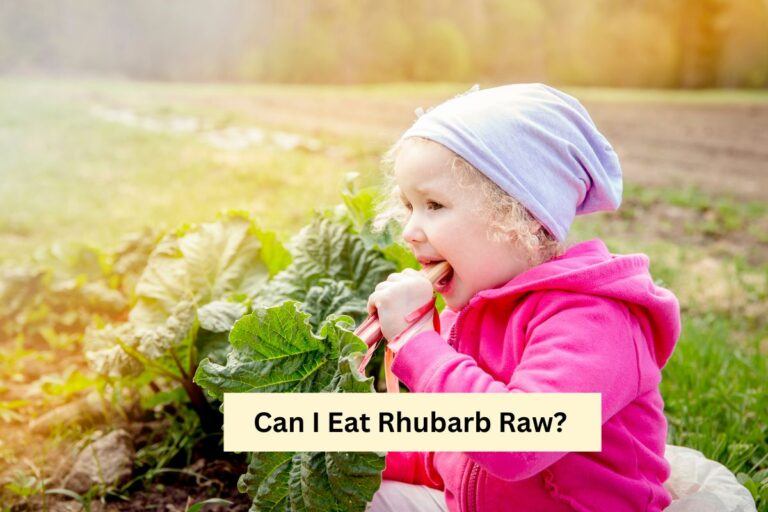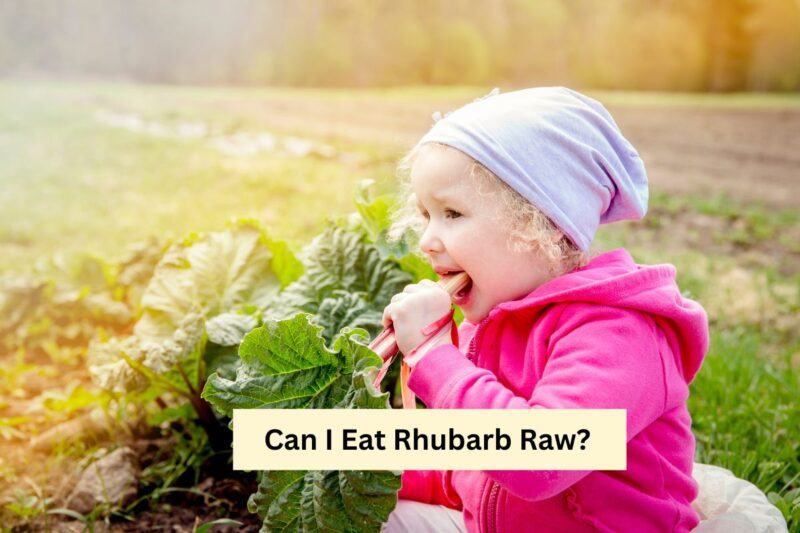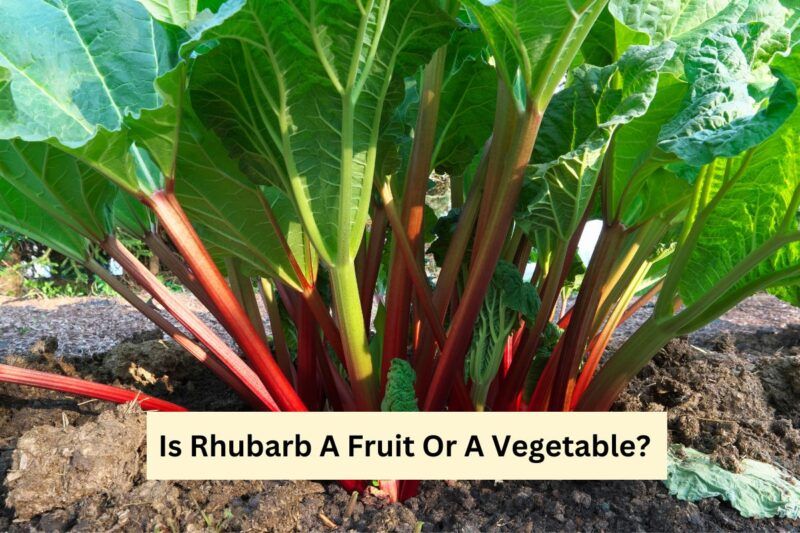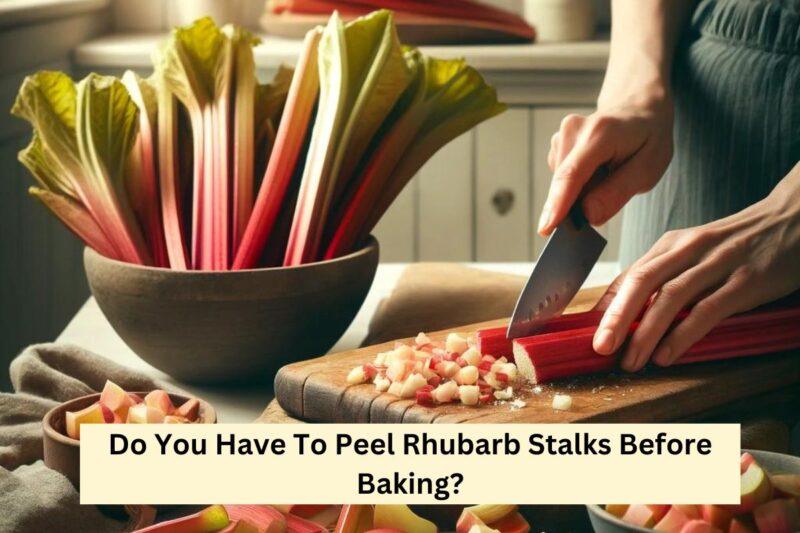You can eat rhubarb raw. But before you do, it’s important to know which parts are safe to eat. The stems of the rhubarb plant are okay to eat raw and have a tart, tangy flavor. But you should never eat the leaves because they contain oxalic acid, which is poisonous.
How to Eat Rhubarb Safely

Eating raw rhubarb isn’t just about the flavor; it’s also about understanding what you’re putting in your body. The stems of the rhubarb plant are edible and have a crisp texture with a tart flavor. However, it is important to remember that the leaves should never be eaten because of their high concentration of oxalic acid, which is poisonous.
Raw rhubarb has lots of vitamins C, vitamin K, and fiber, which is great for a balanced diet. However, some of these vitamins break down when cooked. So, you will get more from eating raw rhubarb.
But you need to remember that raw rhubarb has more oxalic acid than when it is cooked. This can lead to kidney stones, especially if you’re prone to this. So, if you decide to include raw rhubarb in your diet, it’s better to eat it in small amounts.
It’s important to manage the risks that come with eating raw rhubarb. Taking steps like eating it in smaller amounts and not every day will allow you to enjoy this vegetable without the drawbacks.
Comparing Raw and Cooked Rhubarb
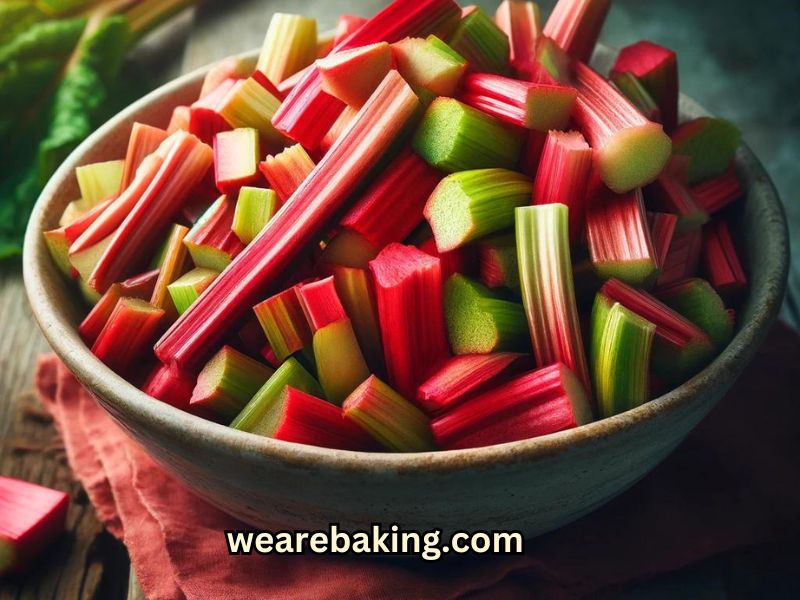
When we talk about eating rhubarb, we often wonder not just if it can be eaten raw but also how it compares to when it’s cooked.
Starting with the taste, raw rhubarb is very tart and can be surprising if you’re not used to it. When it’s cooked, it becomes much less sharp, often because sugar is added. The texture changes too; raw rhubarb is crisp and tough, but cooking makes it softer and easier to eat for most people.
The changes go beyond just taste and texture. Cooking rhubarb can change how your body uses its nutrients. For example, while cooking might break down some vitamins that don’t handle heat well, it can also make it easier for your body to take in other nutrients.
| Nutrient | Raw Rhubarb Content | Cooked Rhubarb Content |
|---|---|---|
| Vitamin C | 10 mg | 4 mg |
| Vitamin K | 29.3 mcg | 28.7 mcg |
| Dietary Fiber | 1.8 g | 1.4 g |
| Potassium | 288 mg | 244 mg |
| Oxalic Acid | High 🚨 | Reduced 😌 |
| Brought to You by “wearebaking.com” | ||
What about digestive comfort? Some find raw rhubarb a bit hard to stomach due to its high fiber content, which remains more intact than in softened, cooked rhubarb. Those with sensitive digestive systems might prefer it cooked to avoid any gastrointestinal discomfort.
How to Prepare Raw Rhubarb Safely
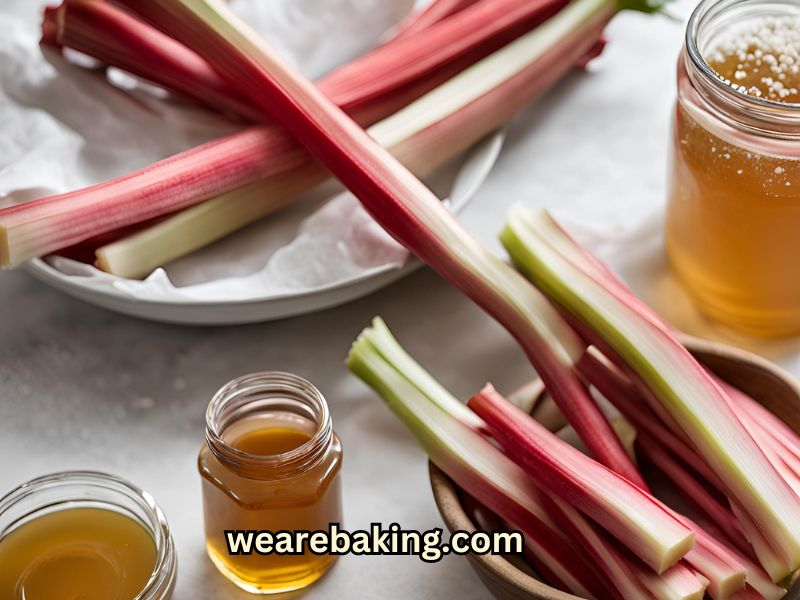
Preparing raw rhubarb is easy, and you don’t need to be a chef to do it right. Here’s how you can safely prepare rhubarb stems to eat:
First, use only the stems of the rhubarb. The leaves are poisonous because they contain oxalic acid, so throw them away immediately.
Wash the stems under running water to clean off any dirt, then cut them into small pieces or however you like to eat them.
Raw rhubarb is quite tart, and you might find it too sour. If that’s the case, you can sprinkle some sugar or pour a little honey over the pieces to make them sweeter.
You can dip the rhubarb pieces in sugar or honey for a quick treat or add them to salads for a fresh, tangy flavor.
If you want to get creative, mix raw rhubarb with other fruits like strawberries or apples. This can help balance the tartness with their natural sweetness.
Another great way to enjoy raw rhubarb is to add it to smoothies or juices. This makes them refreshing and increases their nutritional value.
Remember, how you enjoy rhubarb is up to you. Some people love the sharp taste of raw rhubarb, while others might like it better when it’s a bit milder.
Benefits and Risks
| Health Condition | Rhubarb Consumption Advice | Reason |
|---|---|---|
| Kidney Stones | Limited Intake Recommended | High oxalic acid content may contribute to stone formation. |
| Gout | Consume with Caution | Oxalic acid can exacerbate gout symptoms. |
| Irritable Bowel Syndrome (IBS) | Avoid Raw, Prefer Cooked | Raw rhubarb is high in fiber, which may irritate IBS symptoms. |
| Osteoporosis | Moderate Consumption | Oxalic acid can interfere with calcium absorption. |
| Brought to You by “wearebaking.com” | ||
When you think about adding raw rhubarb to your meals, it’s important to consider both its health benefits and potential risks. On the plus side, rhubarb is low in calories and packed with vitamins and minerals. It has vitamin C, vitamin K, and potassium, and it’s rich in dietary fiber, which is good for your digestive health.
Rhubarb also has antioxidants like anthocyanins and proanthocyanidins. These help fight inflammation and can protect against various diseases. These antioxidants are mainly found in the colorful stems of the plant, so eating raw rhubarb can increase your antioxidant intake.
However, there are some things to be cautious about. Rhubarb contains oxalic acid, a compound that can be toxic in large amounts. The stems have less oxalic acid than the leaves, but it’s still important for people with certain health conditions, like kidney problems or gout, to be careful about how much they eat. Cooking rhubarb lowers its oxalic acid content, but it doesn’t completely remove the risk for those who are sensitive.
If you’re new to eating rhubarb, try a small amount first to see how your body reacts. Watch out for any digestive discomfort, as some people might find raw rhubarb hard to digest at first.
Who should avoid raw rhubarb? If you have had kidney stones, talk to your doctor before adding rhubarb to your diet. Pregnant women should also be cautious, as the effects of high levels of oxalic acid during pregnancy aren’t well known.
Frequently Asked Questions
1. Can raw rhubarb be harmful? Yes, raw rhubarb can be harmful if you eat the leaves, which are toxic, or if you consume too much of it because of its high oxalic acid content.
2. Is raw rhubarb the healthiest way to eat this vegetable? It depends. Cooking rhubarb can lower some nutrients, but raw rhubarb might be too harsh for some people’s digestive systems.
3. How can I make raw rhubarb less tart? A simple way to reduce the tartness is to dip the raw slices in honey or sprinkle them with sugar. This can help balance the sharp, sour taste.
4. What should I do if I have an allergic reaction to rhubarb? If you experience symptoms like itching, swelling, or difficulty breathing after eating rhubarb, you should seek medical attention immediately, as these could be signs of an allergic reaction.
Final Thoughts

You might be looking for a quick answer, so here it is again: Yes, you can eat rhubarb raw. With its tart taste that some people find refreshing and how easy it is to prepare, it could become your new favorite snack or a unique addition to your salads and smoothies.
Like with any food, you should eat raw rhubarb carefully and with good knowledge. Remember, the stems are safe to eat, but the leaves are not—they’re poisonous. Always prepare rhubarb correctly to minimize any risks from its oxalic acid.
Adding a little sweetener or mixing it with other flavors can make its sharp taste more enjoyable, something you might start to love.
Most importantly, pay attention to how your body reacts to new foods. If you have health issues or special diet needs, talk to your doctor about whether rhubarb, whether raw or cooked, is a good choice for you.
Here’s one last thought: Trying raw rhubarb is a chance to mix up your diet, as long as you’re excited but careful. Give it a try and see how it fits into your food explorations.
Have you eaten raw rhubarb? Leave me a comment below.
And As Always
Keep On Baking!
Taianne
Share the Love
Latest Posts

I’m Taianne, the owner and operator behind We Are Baking. Baking my first cake at age 11 hooked me on creating sweet treats. Though my interest faded during childhood, it was rekindled when I married my apple pie-loving husband. I love trying new recipes, tweaking classics, and helping others learn the science and art of baking. I started We Are Baking to share tips, tricks, and favorite recipes I’ve discovered over the years. When not in the kitchen, I enjoy spending time with family and friends. My goal is to inspire others to embrace their creativity through baking. Feel free to contact me with any questions!
Taianne@wearebaking.com

